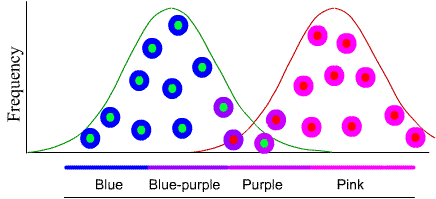Decision-making in the real world
How an animal responds to confusing signals depends on the circumstances. If the danger of a wrong choice is high, or the consequences of a wrong choice are dire, it is better to stay on the "safe side" and avoid most signals that might be wrong. This is the biological meaning of the peak shift.
The three key signal parameters -- relative abundance, distribution, and payoffs -- are just ways of representing these risks in terms of numbers.

Relative abundance (above): if there
are a lot more "nectar flowers" (positive signals) than "non-nectar
flowers", there is less danger of making a wrong choice. The peak
shift will be slight.

Distribution (above): if the two
signals only overlap a little, the danger of making a wrong choice is
low. The peak shift will be slight.

Payoffs (above): if the benefit of making a correct choice is high (above: the nectar flowers have a lot of nectar), and/or the cost of making a wrong choice is low, again the peak shift will be slight.
